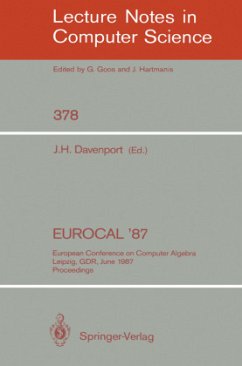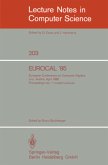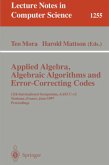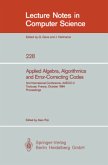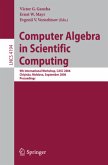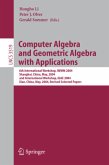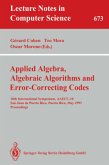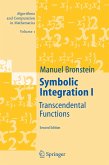James H. Davenport (ed.)European Conference on Computer Algebra, Leipzig, GDR, June 2-5, 1987. Proceedings
EUROCAL '87
European Conference on Computer Algebra, Leipzig, GDR, June 2-5, 1987. Proceedings
Mitarbeit:Davenport, James H.
James H. Davenport (ed.)European Conference on Computer Algebra, Leipzig, GDR, June 2-5, 1987. Proceedings
EUROCAL '87
European Conference on Computer Algebra, Leipzig, GDR, June 2-5, 1987. Proceedings
Mitarbeit:Davenport, James H.
- Broschiertes Buch
- Merkliste
- Auf die Merkliste
- Bewerten Bewerten
- Teilen
- Produkt teilen
- Produkterinnerung
- Produkterinnerung
This is the sixth in a series of conference proceedings of international conferences on computer algebra held in Europe. All the preceding ones have also been published as Lecture Notes in Computer Science. They contain original research material not published elsewhere, and a few invited lectures summarising the state of the art. Computer algebra is the science of using computers to do algebraic calculations, rather than the purely arithmetic calculations which we all know computers can do. These calculations may be polynomial-like calculations - one thread of the conference was devoted to…mehr
Andere Kunden interessierten sich auch für
![EUROCAL '85. European Conference on Computer Algebra. Linz, Austria, April 1-3, 1985. Proceedings EUROCAL '85. European Conference on Computer Algebra. Linz, Austria, April 1-3, 1985. Proceedings]() BuchbergerEUROCAL '85. European Conference on Computer Algebra. Linz, Austria, April 1-3, 1985. Proceedings41,99 €
BuchbergerEUROCAL '85. European Conference on Computer Algebra. Linz, Austria, April 1-3, 1985. Proceedings41,99 €![Applied Algebra, Algebraic Algorithms and Error-Correcting Codes Applied Algebra, Algebraic Algorithms and Error-Correcting Codes]() MoraApplied Algebra, Algebraic Algorithms and Error-Correcting Codes41,99 €
MoraApplied Algebra, Algebraic Algorithms and Error-Correcting Codes41,99 €![Applied Algebra, Algorithmics and Error-Correcting Codes Applied Algebra, Algorithmics and Error-Correcting Codes]() PoliApplied Algebra, Algorithmics and Error-Correcting Codes41,99 €
PoliApplied Algebra, Algorithmics and Error-Correcting Codes41,99 €![Computer Algebra in Scientific Computing Computer Algebra in Scientific Computing]() V.G. Ganzha / E.W. Mayr / E.V. VorozhtsovComputer Algebra in Scientific Computing41,99 €
V.G. Ganzha / E.W. Mayr / E.V. VorozhtsovComputer Algebra in Scientific Computing41,99 €![Computer Algebra and Geometric Algebra with Applications Computer Algebra and Geometric Algebra with Applications]() Hongbo Li / Peter J. Olver / Gerald Sommer (eds.)Computer Algebra and Geometric Algebra with Applications41,99 €
Hongbo Li / Peter J. Olver / Gerald Sommer (eds.)Computer Algebra and Geometric Algebra with Applications41,99 €![Applied Algebra, Algebraic Algorithms and Error-Correcting Codes Applied Algebra, Algebraic Algorithms and Error-Correcting Codes]() CohenApplied Algebra, Algebraic Algorithms and Error-Correcting Codes41,99 €
CohenApplied Algebra, Algebraic Algorithms and Error-Correcting Codes41,99 €![Symbolic Integration I Symbolic Integration I]() Manuel BronsteinSymbolic Integration I93,99 €
Manuel BronsteinSymbolic Integration I93,99 €-
-
-
This is the sixth in a series of conference proceedings of international conferences on computer algebra held in Europe. All the preceding ones have also been published as Lecture Notes in Computer Science. They contain original research material not published elsewhere, and a few invited lectures summarising the state of the art. Computer algebra is the science of using computers to do algebraic calculations, rather than the purely arithmetic calculations which we all know computers can do. These calculations may be polynomial-like calculations - one thread of the conference was devoted to polynomial algorithms - or may relate to other areas of mathematics such as integration, the solution of differential equations, or geometry - a second thread was devoted to those topics. The calculations can be applied in a wide range of scientific and engineering subjects, and in branches of mathematics. Physics has benefitted especially from these calculations, and the proceedings contain many papers on this, and also papers on applications in computer aided design and robotics, to name but a few other applications. The third thread of the proceedings was devoted to these applications and to the computer algebra systems which perform these calculations.
Hinweis: Dieser Artikel kann nur an eine deutsche Lieferadresse ausgeliefert werden.
Hinweis: Dieser Artikel kann nur an eine deutsche Lieferadresse ausgeliefert werden.
Produktdetails
- Produktdetails
- Lecture Notes in Computer Science 378
- Verlag: Springer / Springer Berlin Heidelberg / Springer, Berlin
- Artikelnr. des Verlages: 978-3-540-51517-3
- 1988.
- Seitenzahl: 512
- Erscheinungstermin: 9. August 1989
- Englisch
- Abmessung: 235mm x 155mm x 28mm
- Gewicht: 914g
- ISBN-13: 9783540515173
- ISBN-10: 3540515178
- Artikelnr.: 09207474
- Herstellerkennzeichnung Die Herstellerinformationen sind derzeit nicht verfügbar.
- Lecture Notes in Computer Science 378
- Verlag: Springer / Springer Berlin Heidelberg / Springer, Berlin
- Artikelnr. des Verlages: 978-3-540-51517-3
- 1988.
- Seitenzahl: 512
- Erscheinungstermin: 9. August 1989
- Englisch
- Abmessung: 235mm x 155mm x 28mm
- Gewicht: 914g
- ISBN-13: 9783540515173
- ISBN-10: 3540515178
- Artikelnr.: 09207474
- Herstellerkennzeichnung Die Herstellerinformationen sind derzeit nicht verfügbar.
Computer algebra in physical research of jinr.- Complexity of quantifier elimination in the theory of ordinary differential equations.- Groups and polynomials.- Symbolic computation in relativity theory.- A zero structure theorem for polynomial-equations-solving and its applications.- Some algorithms of rational function algebra.- The computer algebra system simath.- Converting SAC-2 code to lisp.- Computer algebra system for continued fractions manipulation.- Computing a lattice basis from a system of generating vectors.- Expression optimization using high-level knowledge.- Catfact: Computer algebraic tools for applications of catastrophe theory.- Computer algebra application for investigating integrability of nonlinear evolution systems.- Computer classification of integrable seventh order MKdV - Like equations.- Symbolic computation and the finite element method.- Application of lie group and computer algebra to nonliner mechanics.- Hierarchical symbolic computations in the analysis of large-scale dynamical systems.- Schoonschip for computing of gravitino interaction cross sections in N=2 supergravity.- Creation of efficient symbolic-numeric interface.- Automatic generation of FORTRAN-Coded Jacobians and Hessians.- Laplace transformations in reduce 3.- Reduce 3. 2 on iAPX86/286 - based personal computers.- Some extensions and applications of reduce system.- Infinite structures in scratchpad II.- Application of a structured LISP system to computer algebra.- Number-theoretic transforms of prescribed length.- A hybrid algebraic-numeric system ANS and its preliminary implementation.- The calculation of QCD triangular Feynman graphs in the external gluonic field using reduce-2 system.- Computer algebra application for determining local symmetries of differentialequations.- Trace calculations for gauge theories on a personal computer.- Evaluation of plasma fluid equations collision integrals using reduce.- Computerized system of analytic transformations for analysing of differential equations.- Integral equation with hidden eigenparameter solver: Reduce + fortran in tandem.- Combinatorial aspects of simplification of algebraic expressions.- Dynamic program improvement.- Computer algebra and numerical convergence.- Computer algebra and computation of puiseux expansions of algebraic functions.- Boundary value problems for the laplacian in the Euclidean space solved by symbolic computation.- The methods for symbolic evaluation of determinants and their realization in the planner-analytic system.- Transformation of computation formulae in systems of recurrence relations.- "Dimreg" the package for calculations in the dimensional regularization with 4-dimensional ?5-matrix in quantum field theory.- CTS - Algebraic debugging system for reduce programs.- Applications of computer algebra in solid modelling.- Implementation of a geometry theorem proving package in SCRATCHPAD II.- Collision of convex objects.- Solving algebraic equations via Buchberger's algorithm.- Primary ideal decomposition.- Solving systems of algebraic equations by using gröbner bases.- Properties of Gröbner bases under specializations.- The computation of polynomial greatest common divisors over an algebraic number field.- An extension of buchberger's algorithm to compute all reduced gröbner bases of a polynomial ideal.- Singularities of moduli spaces.- Radical simplification using algebraic extension fields.- Hermite normal forms for integer matrices.- Mr. Smith goes to Las Vegas: Randomized parallel computation of the Smith Normal form of polynomialmatrices.- Fonctions symétriques et changements de bases.- Complexity of standard bases in projective dimension zero.- Gröbner bases for polynomial ideals over commutative regular rings.- Some algebraic algorithms based on head term elimination over polynomial rings.- Algorithmic determination of the jacobson radical of monomial algebras.- A recursive algorithm for the computation of the hilbert polynomial.- An affine point of view on minima finding in integer lattices of lower dimensions.- A combinatorial and logical approach to linear-time computability (extended abstract).- Complexity of computation of embedded resolution of algebraic curves.- Polynomial factorisation: an exploration of Lenstra's algorithm.- A matrix-approach for proving inequalities.- Using automatic program synthesizer as a problem solver: Some interesting experiments.- Strong splitting rules in automated theorem proving.- Towards a refined classification of geometric search and computation problems.- Matrix Padé fractions.- Computation of generalized Padé approximants.- A critical pair criterion for completion modulo a congruence.- Shortest paths of a disc inside a polygonal region.- Rabin's width of a complete proof and the width of a semialgebraic set.- Practical aspects of symbolic integration over Q(x).- Integration: Solving the Risch differential equation.- Computation and simplification in lie fields.- A package for the analytic investigation and exact solution of differential equations.- An algorithm for the integration of elementary functions.
Computer algebra in physical research of jinr.- Complexity of quantifier elimination in the theory of ordinary differential equations.- Groups and polynomials.- Symbolic computation in relativity theory.- A zero structure theorem for polynomial-equations-solving and its applications.- Some algorithms of rational function algebra.- The computer algebra system simath.- Converting SAC-2 code to lisp.- Computer algebra system for continued fractions manipulation.- Computing a lattice basis from a system of generating vectors.- Expression optimization using high-level knowledge.- Catfact: Computer algebraic tools for applications of catastrophe theory.- Computer algebra application for investigating integrability of nonlinear evolution systems.- Computer classification of integrable seventh order MKdV - Like equations.- Symbolic computation and the finite element method.- Application of lie group and computer algebra to nonliner mechanics.- Hierarchical symbolic computations in the analysis of large-scale dynamical systems.- Schoonschip for computing of gravitino interaction cross sections in N=2 supergravity.- Creation of efficient symbolic-numeric interface.- Automatic generation of FORTRAN-Coded Jacobians and Hessians.- Laplace transformations in reduce 3.- Reduce 3. 2 on iAPX86/286 - based personal computers.- Some extensions and applications of reduce system.- Infinite structures in scratchpad II.- Application of a structured LISP system to computer algebra.- Number-theoretic transforms of prescribed length.- A hybrid algebraic-numeric system ANS and its preliminary implementation.- The calculation of QCD triangular Feynman graphs in the external gluonic field using reduce-2 system.- Computer algebra application for determining local symmetries of differentialequations.- Trace calculations for gauge theories on a personal computer.- Evaluation of plasma fluid equations collision integrals using reduce.- Computerized system of analytic transformations for analysing of differential equations.- Integral equation with hidden eigenparameter solver: Reduce + fortran in tandem.- Combinatorial aspects of simplification of algebraic expressions.- Dynamic program improvement.- Computer algebra and numerical convergence.- Computer algebra and computation of puiseux expansions of algebraic functions.- Boundary value problems for the laplacian in the Euclidean space solved by symbolic computation.- The methods for symbolic evaluation of determinants and their realization in the planner-analytic system.- Transformation of computation formulae in systems of recurrence relations.- "Dimreg" the package for calculations in the dimensional regularization with 4-dimensional ?5-matrix in quantum field theory.- CTS - Algebraic debugging system for reduce programs.- Applications of computer algebra in solid modelling.- Implementation of a geometry theorem proving package in SCRATCHPAD II.- Collision of convex objects.- Solving algebraic equations via Buchberger's algorithm.- Primary ideal decomposition.- Solving systems of algebraic equations by using gröbner bases.- Properties of Gröbner bases under specializations.- The computation of polynomial greatest common divisors over an algebraic number field.- An extension of buchberger's algorithm to compute all reduced gröbner bases of a polynomial ideal.- Singularities of moduli spaces.- Radical simplification using algebraic extension fields.- Hermite normal forms for integer matrices.- Mr. Smith goes to Las Vegas: Randomized parallel computation of the Smith Normal form of polynomialmatrices.- Fonctions symétriques et changements de bases.- Complexity of standard bases in projective dimension zero.- Gröbner bases for polynomial ideals over commutative regular rings.- Some algebraic algorithms based on head term elimination over polynomial rings.- Algorithmic determination of the jacobson radical of monomial algebras.- A recursive algorithm for the computation of the hilbert polynomial.- An affine point of view on minima finding in integer lattices of lower dimensions.- A combinatorial and logical approach to linear-time computability (extended abstract).- Complexity of computation of embedded resolution of algebraic curves.- Polynomial factorisation: an exploration of Lenstra's algorithm.- A matrix-approach for proving inequalities.- Using automatic program synthesizer as a problem solver: Some interesting experiments.- Strong splitting rules in automated theorem proving.- Towards a refined classification of geometric search and computation problems.- Matrix Padé fractions.- Computation of generalized Padé approximants.- A critical pair criterion for completion modulo a congruence.- Shortest paths of a disc inside a polygonal region.- Rabin's width of a complete proof and the width of a semialgebraic set.- Practical aspects of symbolic integration over Q(x).- Integration: Solving the Risch differential equation.- Computation and simplification in lie fields.- A package for the analytic investigation and exact solution of differential equations.- An algorithm for the integration of elementary functions.

